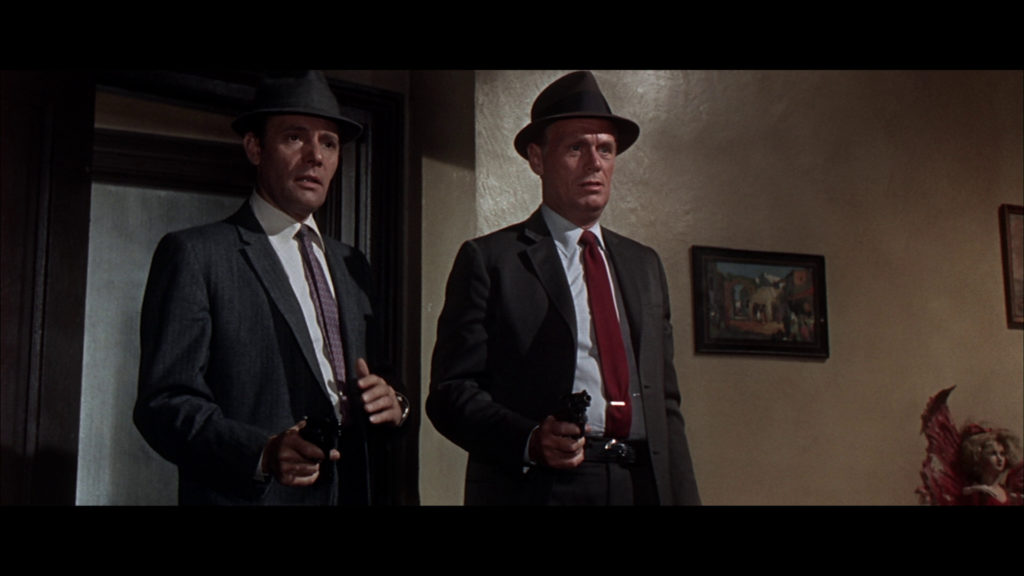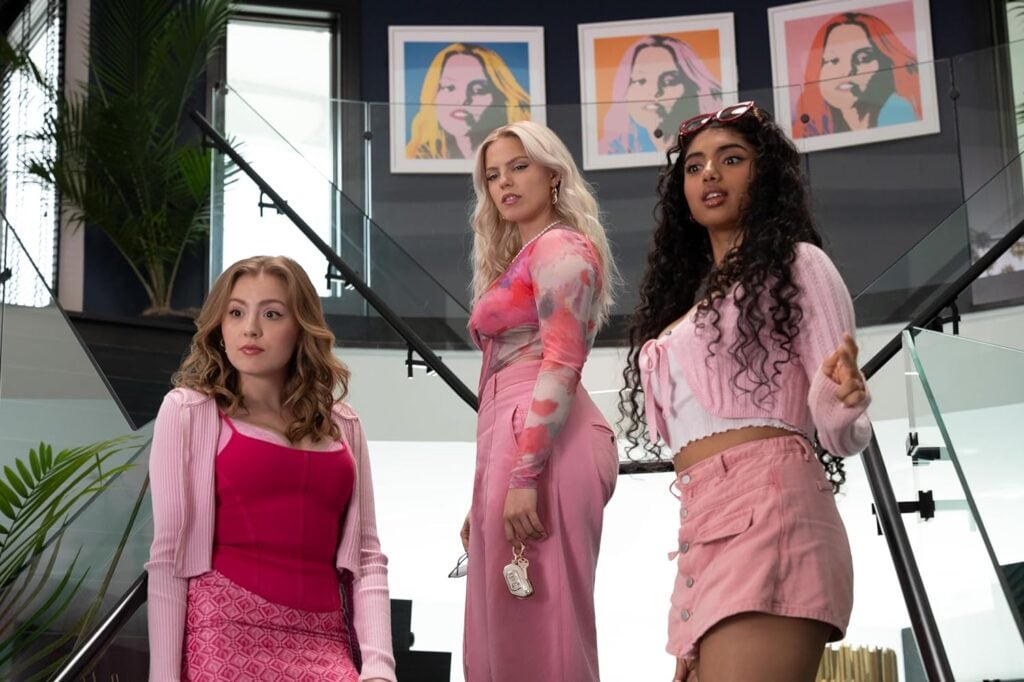Kino has released Don Siegel’s 1968 excellent police melodrama Madigan on Blu Ray. In just a handful of years in the 1960s the thirty-year-old production code crumbled and was soon replaced by the MPAA film rating system in the fall of 1968. The makers of Madigan, released in March of 1968, take full advantage of these changes pushing sex, violence, and moral ambiguity further than action films of just a few years earlier and deliver one of the best cop films of the era. Unfortunately, the transfer is erratic and not nearly as good as it could be.
The Production: 4.5/5
Madigan opens fast on an early Friday morning as detectives Dan Madigan (Richard Widmark) and Rocco Bonaro (Harry Guardino) bust into an apartment in Spanish Harlem for what they believe is a routine pickup of a small-time career criminal, Barney Benesch (Steve Ihnat).
Things quickly go wrong when Benesch notices Madigan staring at the naked girl with him and takes advantage of the distraction by pulling a gun to strip both Madigan and Bonaro of their weapons. He marches the two detectives to the roof where he locks the door and runs down the stairs to the street. Madigan and Bonaro quickly follow but Benesch has too big a lead and escapes.
When Madigan and Bonaro get to the precinct office they learn that the Benesch foul-up is worse than they suspected as Benesch is wanted for homicide. The incident has shot to the top. Police Commissioner Anthony X. Russell (Henry Fonda) gives Madigan and Bonaro 72 hours to bring Benesch in. The 72-hour bit is old, but it gives the movie a sense of urgency.
Madigan is a well-written script by two ex-blacklisted writers, Howard Rodman (under pseudonym Henri Simoun) and Abraham Polonsky. It weaves multiple parallel professional and personal conflicts that conclude in a memorable climax.
Dan Madigan is a flamboyant but essentially honest cop whose personal life is a disaster. Anthony Russell is a hard-working, by-the-book cop whose personal life is also a disaster. Both men have no emotional attachments in spite of being involved with beautiful, loving women.
Madigan is married to a gorgeous, younger woman, Julia (Inger Stevens) who is not well suited for the role of a cop’s wife. Madigan also has a stunning mistress, Jonesy (Sheree North) who sings in a New York nightclub. Neither woman is satisfied with what Madigan has to give.
Russell is unmarried and is having an affair with a New York socialite, Tricia (Susan Clark). Their affair is about to end with the return of Tricia’s husband and children from a camping trip. Russell also learns that his oldest (and one of two) friends, Chief Inspector Charles Kane (an in-joke?) has been caught taking a bribe.
I recently read a description of Madigan as a Neo-Noir. At first, I thought this was incorrect as I usually associate Noir with criminals (often reluctant) who think they’re ahead of the game and yet find themselves trapped in a life of crime – think of Richard Widmark’s Harry Fabian in Night and the City. I’m not sure if this was conscious on anyone’s part but casting Widmark in this role is brilliant because of his earlier noir roles. Benesch is a good villain, but not developed; he exists only to set the movie into motion. But the more I thought about it, it came to me that Madigan works as Cop Noir.
Both Madigan and Russell are so submerged in crime and isolated by their profession that they are unable to function in any other capacity. Bonaro and Kane have families that take precedence over their professional lives. Kane’s transgression turns out to be an effort to save his son.
Madigan and Russell are externally very different characters, yet emotionally the same. Theirs is a life of crime; only on the other side. They are as trapped in this cinematic world as the criminals they pursue. For them there is no way out.
Towards the end of the movie, Madigan practically throws his emotionally starved wife at another cop so he can pursue Benesch – he is as unable to control himself as a criminal committing a crime. Russell seems self-aware enough to have avoided family commitments, to the point in engaging in hopeless affairs with the knowledge that nothing can come of such attachments.
Madigan’s most human moment is when after given a bum tip by a drunken informer, he explains the mistake to the frustrated Bonaro, ‘You know what that was about? He was lonely.’ The exchange is played as comic, but in that one moment he has given a street rummy more consideration than he does his wife throughout the whole movie.
For Russell the humanizing moment comes when his about-to-be ex-mistress tells him he is being too hard on his friend Kane. To banish Kane is tantamount to banishing himself emotionally, as Russell has few friends he can afford to lose.
Madigan sports an incredible cast of character actors. Along with those actors already mentioned, you have Michael Dunn, Don Stroud, Warren Stevens, Raymond St. Jacques, Bert Freed, and Harry Belaver. All performances are good, with some on the eccentric side. It’s almost unthinkable for a contemporary movie with such a strong cast.
Madigan is expertly directed by Don Siegel, who in 1968 was a 20-year directing vet who broke into the business as a montage editor at Warner Bros. Siegel directed many good to great movies (Riot in Cell Block 11, Invasion of the Body Snatchers, The Lineup, The Killers) but his reputation seemed modest until his association with Clint Eastwood – the similarly themed Dirty Harry redefines the action film in the early 70s.
Siegel directs in a clean, no-nonsense style. Action scenes are staged with a meticulous, almost mathematical precision. Siegel uses New York locations well, but one of the film’s few flaws is the use of the Universal backlot for some of the scenes. I’m guessing this was due to budgetary concerns.
This may just be me, but I have no problem with movies shot entirely on studio sets. I buy Warner’s lower east side set in Angels with Dirty Faces. I have no problem with the sets in Dead End. But after films start using real locations in the late 1940s, I almost always find it problematic when filmmakers try to match location work with sets. As much as I love Hitchcock and ignore this practice in his later movies, I’m skeptical when defenders say this was an aesthetic choice.
In Madigan this is most jarring when you go from a New York street into a movie theater interior that doesn’t look anything like any New York movie theater I ever saw (though I do like the art direction of the manager’s office). The scene of Benesch gunning down two policemen with Madigan’s gun was shot on the Universal lot and looks nothing like a New York street. The climax was also shot at Universal and looks it. One does wonder how much money was saved shooting this way?
Madigan was probably the first ‘adult’ movie I saw in a theater. In September of 1968 it played at my westside Cleveland neighborhood theater on a double bill with King Kong Escapes. They even included a Chilly Willy cartoon. I can’t imagine what the booker or theater management was thinking, but to this day, it’s one of my favorite double features of all time. It doesn’t take a lot of imagination to figure out what this then seven-year-old was there for, but I have to confess that Madigan with its sex, violence, and bad language knocked my young socks off, particularly the downbeat ending.
Video: 2.5/5
3D Rating: NA
The transfer for Madigan is problematic. I’m not sure how old or the source of this transfer. It was shot in Techniscope by the great Russell Metty (The Stranger, All That Heaven Allows, A Touch of Evil, Spartacus). Metty was Universal’s best DP. This is towards the end of Metty’s career, a period when he was doing a lot of television work. A lot of Universal film and television product of this era looks similar. I’m sure this was dictated by management. On the plus side this transfer of Madigan has better detail and is darker than any television print or previous video edition I’ve ever seen. The bad part is the erratic color. Some scenes look ok and other scenes look faded. Widmark’s face goes from ruddy to sickly. In some scenes Harry Guardino’s face looks yellow.
Audio: 4/5
The audio is good. Dialogue and music are clearly distinguishable. The lush score by Don Costa at first listen seems odd, nothing like Lalo Schifrin’s work for director Siegel (Coogan’s Bluff, The Beguiled, Dirty Harry, Charley Varrick). Costa’s score seems more appropriate for a 1950s melodrama than a gritty, late 1960s New York cop movie. Once you adjust your expectations, the score works as both Madigan and Russell seem like men from another era and the music reflects what would have been their peak years.
Special Features: 3/5
Special Features include:
A new commentary by Howard S. Berger, Steve Mitchell, and Nathaniel Thompson. Most of what they cover is easily found through a Google search. They mention that the movie was shot in Cinemascope, but as I wrote above, it was shot in Technicsope and the process is even given its own credit.
Theatrical trailer/TV Spots, and a promo for the television series – love that TV spot – “He goofed – he kept his eye on the broad!”
Overall: 3/5
The blu ray of Madigan is unfortunately a missed opportunity. It’s is a major work from a great genre director, but the reputation isn’t as high as Siegel’s Dirty Harry or Charley Varrick. The last US transfer of Madigan was an ugly non-anamorphic DVD released around 20 years ago. When major titles like The Searchers or Rio Bravo are botched fans can reasonably hope for a better transfer on disc someday. With a movie like Madigan this may be the end of the line on physical media. Perhaps the 8K streaming edition?
https://www.amazon.com/Madigan-Blu-ray-Richard-Widmark/dp/B07X3QFY79/ref=sr_1_3?crid=3N07HSLFORWZV&dchild=1&keywords=madigan+blu+ray&qid=1590451022&s=movies-tv&sprefix=madi%2Caps%2C415&sr=1-3
Post Disclaimer
Some of our content may contain marketing links, which means we will receive a commission for purchases made via those links. In our editorial content, these affiliate links appear automatically, and our editorial teams are not influenced by our affiliate partnerships. We work with several providers (currently Skimlinks and Amazon) to manage our affiliate relationships. You can find out more about their services by visiting their sites.






Similar threads